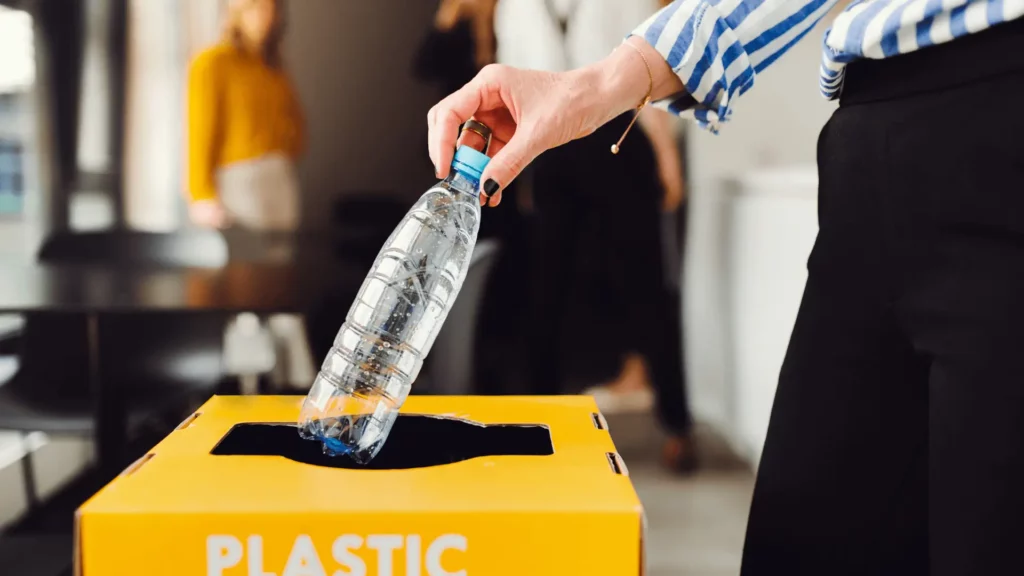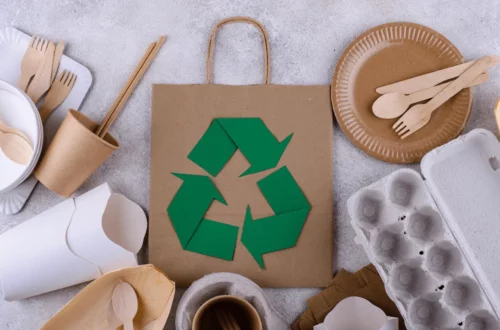Make a Difference with These 11 Waste Recycling Ideas

Are you looking for ways to make a positive impact on the environment? Recycling is not only a responsible choice but also a powerful way to contribute to a greener planet. Imagine the difference we could make if we all took small steps to reduce waste and conserve resources.
In this article, we will explore 11 waste recycling ideas that are both creative and practical. These ideas will not only help you reduce your environmental footprint but also inspire others to join the movement. From simple habits like using a recycle bin to innovative projects like upcycling, we will cover a range of strategies to make recycling a part of your everyday life.
Whether you’re interested in recycling e-waste, paper, plastic, or even food waste, we’ve got you covered. Our goal is to provide you with actionable tips and insights to help you make a difference.
So, let’s roll up our sleeves and dive into these 11 waste recycling ideas that will transform the way you think about waste.
Introduction to Waste Recycling
Waste recycling plays a vital role in protecting our environment and preserving valuable resources. By recycling, we can reduce pollution, conserve energy, and minimize the amount of waste sent to landfills. The concept of waste recycling revolves around the three R’s: Reduce, Reuse, and Recycle. These principles guide us in adopting sustainable habits and making a positive impact on the planet.
Recycling not only helps to conserve resources but also reduces the greenhouse gas emissions associated with the production of new materials. It is a crucial step towards creating a circular economy where products are reused and materials are continuously recycled.
By participating in waste recycling initiatives, we encourage the growth of industries that produce recycled products. Supporting the market for such products ensures that our discarded materials find new life and reduces our reliance on virgin resources.
Making small changes in our daily lives can have a significant impact on waste reduction. Recycling starts with anticipating recyclable materials and choosing products with sustainable packaging. It also involves responsible disposal practices, such as keeping recyclables clean, dry, and empty.
Return to the Three R’s
The three R’s – Reduce, Reuse, Recycle – serve as the fundamental principles of waste recycling. By understanding and practicing these principles, we can make a significant impact on reducing waste and contributing to a more sustainable future.
1. Reduce: The first step is to minimize the amount of waste we generate. By being mindful of our consumption habits, we can make conscious choices to buy products with less packaging, opt for reusable items instead of single-use alternatives, and avoid unnecessary purchases altogether.
2. Reuse: Reusing items adds a second life to them, reducing the need for new production and ultimately lessening the strain on natural resources. Consider repairing and repurposing items rather than simply discarding them. Donate unwanted but still usable items to charities or swap with friends and neighbors.
3. Recycle: Recycling is the process of transforming waste materials into new products, conserving resources and reducing the strain on landfills. Sort your waste into different recycling categories, such as paper, plastic, glass, and metal, and ensure they are properly prepared before placing them in the recycling bin.
By embracing the three R’s and incorporating them into our daily lives, we can make a positive impact on waste reduction and create a more sustainable future for generations to come. Remember, every small action counts, and collectively, we can make a significant difference.
Also read: The Importance of Implementing the 5Rs of Waste Management
Buy Recycled Products
Supporting the market for recycled products is not only environmentally responsible but also contributes to a circular economy. By choosing recycled products, you’re actively participating in the sustainable use of resources and reducing the demand for virgin materials. Whether it’s recycled paper, plastic, or metal, these products have undergone a transformation from waste into valuable resources.
Purchasing recycled goods helps to close the recycling loop, ensuring that the materials we recycle are actually being reused and made into new products. This reduces the need for extracting raw materials, saves energy, and minimizes pollution associated with manufacturing processes.
Next time you go shopping, keep an eye out for products with the recycled symbol or labels indicating their recycled content. By buying recycled, you are making a positive impact on the environment and supporting a more sustainable future.
Remember, your purchasing choices have the power to drive market demand and influence manufacturers to embrace more sustainable practices. So, let’s make a difference by consciously opting for recycled products whenever possible.
Anticipate Recycling
When it comes to waste recycling, being proactive can make a significant difference. By anticipating recycling opportunities and making conscious choices, you can contribute to a greener planet. Here are some tips on how to plan ahead for recycling:
1. Choose products with recyclable packaging: Look for items that come in recyclable materials such as glass, paper, or cardboard. Avoid excessive packaging whenever possible.
2. Opt for products with recyclable materials: Prioritize items made from recyclable materials such as plastic bottles with the recycling symbol.
3. Support companies with sustainable practices: Research and choose brands that prioritize eco-friendly packaging and materials.
Avoid Using Garbage Bags
Using garbage bags may seem like a convenient way to collect and dispose of waste, but it has significant environmental consequences. Plastic garbage bags contribute to the growing issue of plastic pollution, which poses a threat to ecosystems and wildlife. Instead of relying on disposable bags, consider using designated recycling bins for recyclable materials and composting bins for organic waste. By separating your waste properly, you can help reduce the amount of waste going to landfills and contribute to a cleaner and healthier environment.
Refrain from Shredding Paper
Shredding paper may seem like a responsible way to dispose of sensitive documents, but it poses challenges when it comes to recycling. The shredded paper becomes difficult to sort and process at recycling facilities, often ending up as low-quality material that cannot be effectively recycled. Instead of shredding paper, consider alternative options to reduce waste and give it a new purpose.
Use it for Compost
One eco-friendly solution is to add shredded paper to your compost pile. It acts as a carbon-rich “brown” material, aiding in the decomposition process and providing essential nutrients for your compost.
Get Creative with Crafts
Another fun option is to repurpose shredded paper for crafts. From papier-mâché projects to handmade paper, there are numerous creative possibilities that can give shredded paper a second life.
By exploring these alternatives, you can minimize waste, contribute to recycling efforts, and unleash your creativity in sustainable ways.
Also read: How to Achieve a Zero-Waste Bathroom
Properly Recycle E-Waste
Electronic waste, or e-waste, poses a significant challenge to the environment if not disposed of properly. With technological advancements and the constant influx of new gadgets, it’s crucial to understand the importance of responsible e-waste recycling. By recycling e-waste, we can prevent harmful materials from ending up in landfills and promote the extraction of valuable resources for reuse. Here are some guidelines on how to properly recycle e-waste:
1. Find a certified e-waste recycling facility
When looking to recycle your old electronic devices, ensure you choose a certified e-waste recycling facility. These facilities have the expertise and infrastructure to handle e-waste safely and responsibly.
2. Remove personal data and information
Before recycling any electronic device, make sure to remove all personal data and information. This can be done by performing a factory reset or wiping the device clean.
3. Separate batteries and other hazardous components
Certain electronic devices, such as smartphones and laptops, contain batteries and other hazardous components. It’s essential to remove and separate these components before recycling the rest of the device. Many recycling facilities have specific procedures for handling batteries safely.
4. Donate or sell working devices
If your electronic device is still in working condition, consider donating or selling it instead of recycling it. This allows someone else to benefit from its use and extends the lifespan of the product.
5. Check local regulations
Different areas may have specific regulations regarding the disposal and recycling of e-waste. Before recycling any electronic device, familiarize yourself with local guidelines to ensure compliance.
Remember, proper e-waste recycling not only helps protect the environment but also promotes the sustainable use of resources. By taking these steps, you can make a difference in ensuring that e-waste is managed responsibly and contributes to a greener future.
Also read: The Ultimate Guide to Zero Waste Living
Keep Recyclables Clean, Empty, and Dry
Properly preparing recyclable items is crucial to ensure their successful recycling and prevent contamination. Here are some essential steps to follow:
1. Clean your recyclables: Rinse food containers, bottles, jars, and other recyclable materials to remove any residue or food particles. This helps prevent contamination and ensures that the recycling process is successful.
2. Empty containers: Make sure to empty all liquids or substances from containers before recycling them. This ensures that the recycling facility can focus solely on processing the materials and prevents any potential issues during the recycling process.
3. Dry items before recycling: Moisture can cause issues during the recycling process. Before placing recyclables in the recycling bin, make sure they are dry. Wipe them with a cloth or air-dry them to avoid any potential complications.
By following these simple steps, you can contribute to more efficient recycling practices and help protect the environment. Remember, clean, empty, and dry recyclables play a vital role in maintaining the quality of recycled materials.
Reuse Your Water
Water conservation is an essential aspect of waste recycling and sustainable living. By reusing water, you can significantly reduce your water consumption and make a positive environmental impact. Here are some tips to help you reuse water effectively:
1. Water your plants with leftover water from washing dishes or cooking.
2. Collect rainwater in barrels or buckets and use it for outdoor chores like watering your garden.
3. After boiling vegetables or pasta, let the water cool and use it to nourish your plants.
4. Use leftover water from pet bowls or water bottles to hydrate indoor plants.
5. Save water used for cleaning fruits and vegetables and reuse it to water your plants.
By incorporating these simple practices into your daily routine, you can contribute to water conservation efforts and promote a greener lifestyle.
Also read: How Sustainable Waste Management Can Benefit Your Business and the Environment
Get Crafty
Recycling doesn’t have to be boring! By getting crafty, you can find exciting ways to repurpose waste materials and create something new. Here are some DIY projects and upcycling ideas to inspire your creativity:
1. Plastic Bottle Planters: Cut the bottom off plastic bottles and turn them into unique planters for your indoor or outdoor plants.
2. T-Shirt Tote Bags: Transform old, unused t-shirts into stylish and eco-friendly tote bags, perfect for shopping or carrying everyday essentials.
3. Glass Jar Organizers: Repurpose glass jars as storage containers for small items like buttons, nails, or spices. Decorate them for a personalized touch.
4. New Life for Old Furniture: Give new life to old furniture by sanding, painting, or reupholstering them. You’ll create a one-of-a-kind piece while reducing waste.
5. Pallet Furniture: Use discarded wooden pallets to create unique and rustic furniture pieces like outdoor benches or coffee tables.
6. CD Wall Art: Turn old CDs or DVDs into eye-catching wall decor by painting them or creating a mosaic.
7. Jewelry from Scraps: Repurpose old keys, buttons, or broken jewelry to create stunning and unique accessories.
Remember, the possibilities are endless. Let your imagination run wild and get crafty with recycling! Not only will you have fun creating something new, but you’ll also contribute to reducing waste and protecting the environment.
Support Charitable Organizations
When it comes to reducing waste and making a positive impact on the environment, turning to charity organizations can be a rewarding choice. Instead of simply throwing away reusable items, consider donating them to those in need. Not only does this help reduce landfill waste, but it also provides an opportunity for others to benefit from items that may still be in good condition. Clothes, furniture, electronics, and various household items are just a few examples of what can be donated. Check local charities or thrift stores to find organizations that accept donations. By giving your items a second life, you contribute to a more sustainable and compassionate society.
Get the Whole Family Involved
Involving the entire family in waste recycling efforts is not only a great way to strengthen bonds but also instill long-lasting habits that promote environmental sustainability. By actively engaging everyone in the household, you can create a collective impact and raise awareness about the importance of waste recycling. Here are some ideas and strategies to get started:
1. Educate and Raise Awareness
– Talk to your family members about the benefits of waste recycling, such as conserving resources and reducing pollution.
– Share relevant statistics and facts about the environmental impact of recycling.
– Explain the different types of waste that can be recycled, including paper, plastic, glass, and metal.
2. Set Up Recycling Stations
– Designate specific bins or containers for different types of recyclable materials.
– Place them in convenient locations throughout your home, such as the kitchen, living room, or garage.
– Clearly label each bin to make it easy for everyone to identify where each item belongs.
3. Make Recycling a Routine
– Establish a regular schedule for emptying and sorting recyclables.
– Encourage family members to make it a habit to recycle before throwing things away.
– Lead by example and consistently follow the recycling guidelines yourself.
4. Organize Recycling Projects
– Plan fun and creative recycling projects that involve the whole family.
– Upcycle old items into new and useful products, such as turning plastic bottles into planters or creating artwork from recycled materials.
– Involve children in crafting activities that promote recycling awareness and creativity.
5. Support Community Recycling Initiatives
– Participate in local recycling programs and events.
– Encourage family members to join community clean-up activities or volunteer at recycling centers.
– Explore partnerships with schools, local municipalities, or environmental organizations to amplify your impact.
Remember, involving the whole family in waste recycling is not only about creating a cleaner environment but also fostering a sense of responsibility and teaching valuable life skills.
Also read: The Rise of Upcycled Clothing: A Sustainable and Stylish Fashion Choice
Request More Information
If you’re looking to delve deeper into waste recycling and explore more ways to make a positive impact on the environment, don’t hesitate to request more information. There are numerous organizations and recycling centers that are dedicated to promoting sustainable practices and providing helpful resources to individuals like you. By reaching out to these entities, you can gain valuable insights into waste management, recycling techniques, and innovative initiatives.
Consider contacting local recycling centers or waste management departments to learn about recycling programs available in your area. They can provide specific guidelines on how to properly recycle various materials, including e-waste, plastics, paper, glass, and metal. These organizations may also offer educational materials and workshops that can further enhance your knowledge and inspire you to take action.
Remember, knowledge is power when it comes to waste recycling. Don’t hesitate to seek out more information and engage with organizations that share your passion for a sustainable and clean environment.
Additional Resources for Waste Recycling:
Local Recycling Centers- https://www.recyclebycity.com/
Environmental Conservation Organizations- https://www.greenpeace.org/
Waste Management Department- https://www.epa.gov/smm





